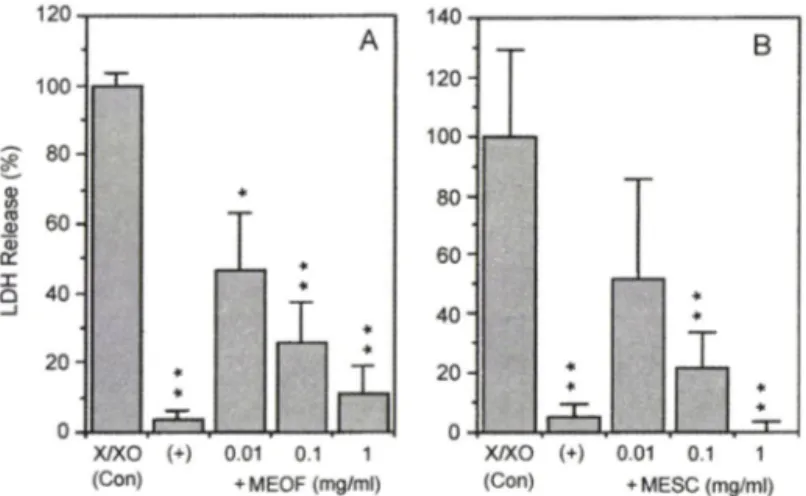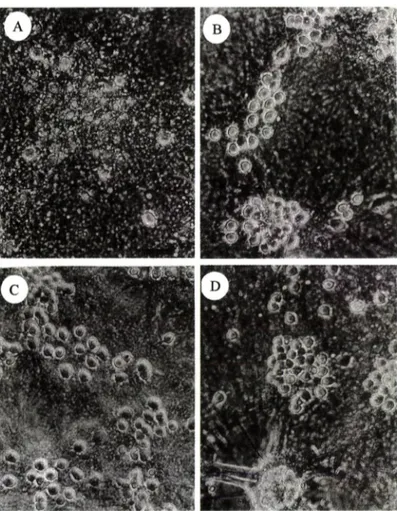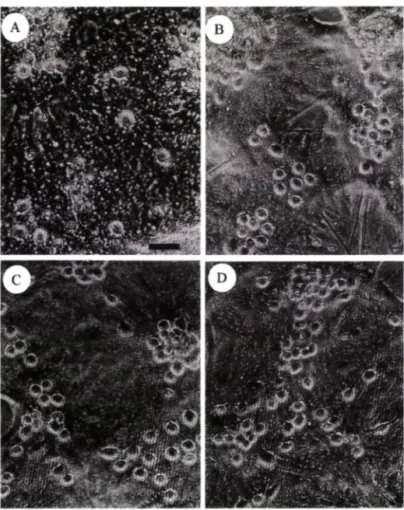약학회 지 제 44 권 제 6 호 613~619(2000)
Yakhak Hoeji Vol. 44, No. 6
생쥐 퍼질세포배앙에서 Free Radical 유발 신경손상에 대한 손바닥선언장 및 삼백초의 보호효과
위 명 복 # 제주대학교 수의학과 (Received October 31, 2000)
Protective Effects of Opuntia Ficus-Indica and Saururus Chinensis on Free Radical-Induced Neuronal Injury in
Mouse Cortical Cell Cultures
Myung-Bok Wie
Department of Veterinary Medicine, Cheju National University, Cheju 690-756, Korea
Abstract — — The author examined whether the methanol extracts of Opuntia ficus-indica fruit and Saururus chinensis have the inhibitory action on xanthine/xanthine oxidase (X/XO)-, FeCl/ascorbic acid- and arachi
donic acid-induced neurotoxicity in mouse cortical cell cultures. The methanol extracts (10|ig/m/~l mg/m/) of Opuntia ficus-imiica and Saururus chinensis were exhibited 53-89% and 48—100% inhibitory action on X/
XO-induced neurotoxicity, respectively. At the range of same concentration, both extracts also attenuated the FeCyascorbic acid-induced neurotoxicity by 35—100% and 15—98%, respectively. In arachidonic acid neu
rotoxicity, the methanol extracts (1 mg/m/) of Opuntia ficus-indica and Saururus chinensis reduced neuronal injury by 22% and 38%, respectively. These results suggest that Opuntia ficus-indica fruit and Saururus chinensis may contribute the neuroprotection in certain free radical-mediated neuronal injury.
Keywords □ Opuntia ficus-indica, Saururus chinensis, neuroprotection superoxide anion radical, hydroxyl radical, arachidonic acid, mouse cortical cultures.
손바닥 선 인 장 윤 ^ ficus-indica, 제주도 기념물
35 호)은 복제주군 한림읍 월령리에 야생으로 군락을
이루어 자라는 열대성식물로서 *> 항염증,자 혈당강하 ,^>
위궤양 억제 ,4> 항 산 화 작 용 면 역 기 능 증강등의 효능 이 었는 것으로 알려지면서 관상용 뿐만 아니라 현재 제주도 농가에서 혁용작물로 많이 재배되고 있다 . 또 한 삼백초 (Sawm m s chinensis, 산림청지정 희귀 멸중
식물 제 177 호)는 북제주군 한경면 고습지와 바닷가에
주로 분포하며 / > 에로부터 부중완하 및 이뇨등의 목적
으로 민간약으로 널리 사용되어 왔으며 *> 최근 간보호 작용 , ® 함함 *'> 및 진통작용*"버 있는 것으로 보 2 되
본 논문에 관한 문의는 이 저자에게로 ( 전화 ) 064-754-3362 ( 팩스 ) 064-756-3354
어 있다 . 한편 , 퇴행성 뇌질환 ( 뇌졸증 , 치매 , 파킨슨씨 병등)으로 인한 뇌신경세포의 손상과정에서 나타나는 주된 병리현상의 특징으로 글루타데이트 (glutam ate) 수 용체의 과도한 홀분•으로 인한 신경세포내의 칼슘유입 증가와 더불어 arachidonic acid 대사증가와 관련하여
prostaglandins 의 합성증가로 이어지는 염증반응이 관
련됨이 잘 알려져 었 다 . * ^ 또 한 이 과정에서 산화적 스트레스 (oxidative stress) 반응과 관련한 superoxide anion radical(02~) 및 hydroxyl radical(OH~) 등이 신경세포의 손상내지는 죽옴과 밀접한 관련이 있다는
실이 밝혀져 었 다 . * * 특 히 중추신경계에서 고농도 로 존재히는 동분성 아미노산인 glutamate 및 aspar- tate 는 학습 및 기억과 관련하식 신경전달물질로서 중 요한 역할을 할 뿐만 아니라 중추신경계의 대사 및 신
613
614 위 명 복
경성장인자로서도 작용하는 것으로 알려져 있다 . 고 *** 그 러나 뇌졸중등의 뢰행성뇌손상에 의해 일시적으로 과 도한 홍 S '성 신경견달물질인 glutamate 혹은 aspartate 분비가 일어날 시 홀&성아미노산의 주요 수용체가 과
도하게 자극을 받아 뇌손 ^0^1 일어나게 된다.*자 그러
나 이러한 홍분성아미노산과 관련된 수용체를 차단하 는 화합물들어 심각한 부작용 때문에 임상시험에서 새 로운 의약품으로 아직까지 인정을 받지 못하고 있는
실정이다 .25) I 다라서 제주도 자원식물들인 손바닥 선인
장 열매와 삼백초의 메탄을 추출물이 이러한
glutam ate 수용체의 자국으로 인한 신경세포외 손상과
정에 관여하는 것으로 알려진 free radical 의 생성중가 와 arachidonic acid 투여로 인한 뇌신경세포 손상에 방어효과가 었는지 알아보고자 생쥐 괴질신경세포를 초대배양 (prim ary culture )하여 조사하였다 .
재 료 및 방법
식물추출물 제조
제주시내 오일장에서 구입한 제주산 손바닥선인장
열매 및 삼백초률 잘 건조시킨 다옴 70% methanol
(M eO H )에 300 g l.5 L 되게 2-3 일간 침적시켜 놓은
다옴 8 0 X 수욕조에서 3 시간 정도 가열하쉬 회견식
중발기를 사용하여 농축시킨 다옴 -80°C 에서 동결시켜
진공동결건조기를 사용하여 powder 형태로 검색시료
률 제조하 H -20°C 에 밀봉 보관하였다가 실험에 시용
하였다 .
생쥐 뇌의 글리아 및 신경세포의 배양
Rose 등의 방법2®*에 따라 뇌의 피질신경세포룰 배양
하기 전 , 글리아률 배양하기 위해 먼저 생후 1~3 일의
생쥐 새끼를 거즈가 바닥에 깔린 조그만 병안에
halothane 을 점적한 디음 넣고 마개률 막아 마취가 될
때까지 기다렸다가 마취가 완료되면 생쥐 새끼를 꺼내
70 %의 에란올이 담겨져 있는 60 m m 배양접시 위에서
목부위를 가위로 절개하여 에틴을에 .담근 채로 1~2 분
정도 기다린 다옴 순서대로 하나씩 머라를 절개용 배 양액에 옮겨 두피률 제거하고 두개골을 가위로 자른 다옴 뇌실질을 끄집어 내었다 . 이렇게 모은 뇌조직들 을 다른 배양액에 옮긴 다옴 한마리씩 입체현미경 하 에서 뇌막을 제거한 다옴 순서대로 뇌의 피질 부위률 멸균된 미세 핀셋으로 잘랐다 . 이렇게 채취한 대뇌피
질조직들은 0.09% trypsin 이 있는 시험관에 넣어 37°C 에서 1 시간 배양하였다 . 그후 이를 꺼내 500Xg 에서 5 분■간 원심분리시킨 다옴 상등액을 버리고 여기 에다 각각 10 %씩의 우태가 및 말의 혈청이 있는 Eagle's m inim al essential m edium (M EM ) 배양액을 1 ml 넣어 파스테르 과 <>1 뱃으로 뇌세포를 여러번 왕 복하여 부서지게하늬 하나씩의 세포로 모두 분리될 때 까지 여러번 반복한 다옴 epidermal growth factor 률 첨가하여 24 well 의 배양판에 0.5-0.75 대뇌반구 /plate 농도로 각각 400 H /씩 분주하였다 . 첫 2 주간은 그냥 방치하고 그 이후는 1 주일 마다 1 회씩 배양액을 2/3 씩 교환하였다 . 이렇게 하쉬 자란 3~ 6 주 정도된 글리아 를 기질로 신경세포률 키우기 위해 임신 15~16 일된 생쥐를 동일한 마취제를 사용하늬 무균적으로 임신된 자궁을 꺼낸다음 역시 뇌률 적출하여 대뇌피질 부위를 입체현미경하에서 머세 핀셋으로 깔라 동일하게 단리 세포로 만든 다옴 글러아 위에 배양하였다 . 이때 글리 아를 키우던 배지는 모두 제거하고 우태가 및 말의 혈 청이 각각 5 %씩 둘어 었는 M E M 배지를 400 10 /되 게 하쉬 세포룰 유지하였다 . 그리고 5~7 일째 비신경 세포의 성장을 억제하기 위해 cytosine arabinoside
(lO u m )를 첨가하였고 이렇게 하식 2 주 이상 신경세포
를 키워 성숙하게 되었을 시 실험에 사용하였다 . 이 때 신경손상유발 독성물질과 이돌 두 식물추출물을 배 앙세포에 농도별로 각각 가하쉬 방어효눙을 조사하였 다 .
Free rad ical 관련 신경손상 유발
Superoxide anion radical 로 인한 신경손상에 대혜 손바닥선인장 및 삼백초 메탄올추출물의 방어효능을 조사하기 위해 xanthine(0.5 m M )/xanthine oxidase (lO m U /m /)를 HEPES-buffered control salt solution
(H C SS )에 녹여 배양신경세포에 10 분간 노출시킨 뒤
(이때 식물추출물을 농도별로 동시에 처러 , 대조군은
무처리 ) 다시 m e m 배양액으로 교환하고 20~24 시간
뒤 Lactate dehydrogenase(LDH) 률 정량하여 대조
군과 비교평가 하였다 . Hydroxyl radical 로 인한 신
경손상에 대해 이들 두 식물추출물의 방어효능을 조
사하기 위해서는 FeCl2(50 |j,M)/ascorbic acid(25 |iM)
롤 HEPES- buffered control salt solution(H CSS)
에 녹여 배양신경세포에 2 시간 노출시킨 뒤(이때 식
물추출물을 농도벌로 동시에 처리 , 대조군은 무처리 )
X/XO (+) 0.01 0.1 1 X/XO (+) 0.01 0.1 1
(Con) + mEOF (mg/ml) (Con) + MESC (mg/mi)
Fig. 1 - Methanol extracts of Opuntia ficus-indica (MEOF) (A) and Saururus chinensis (MESC) (B) attenuate xanthine (0.5 mM)/xanthine oxidase (10 mU/m/) (X/XO)-induced neurotoxicity dose-dependently. The bars denote LDH release (mean ± SEM, n=4) in sister cultures 20—24 h after a 10 min exposure to X/XO alone, with the addition of 50 U/ml catalase (+), or with the addition of MEOF or MESC at the indicated concentrations. The differences were evaluated with one-way ANOVA and the post-hoc Student-Neuman-Keuls test for multiple comparisons (*p<0.01, **p<0.001 vs. controls).
.시 A
6. X
Vol. 44, No. 6, 2000
손바닥•선인장 및 삼백초의 신경보호효과 615
다시 MEM 배양액으로 교환하고 20~24시간 뒤 LDH를 정량하여 대조군과 비교평가 하였다. Ara
chidonic acid로 인한 신경손상에 대해 이둘 두 식물 추출물의 방어효능을 조사하기 위헤서 100^1]^1의 arachidonic add률 식물추출물과 동시에 MEM 배앙 액 상에서 처리하고 20~24시간 뒤 LDH를 정량하여 대조군과 비교평가 하였다.
신경세포의 손상측정
신경세포의 손상은 배양세포에서 세포밖의 배양액으 로 분비되는 L D P * 측정하였는데 손상 및 파괴된 세 포로부터 분비가 거의 완료되는 20~24시간 정도에서 세포 배양액을 채취하여 microplate reader로 죽정하 였다. 이 방법은 흥분성아미노산 및 유리라디칼로 인 한 배양신경세포 득성시 LDH의 분비가 손상 및 파괴 된 신경세포수와 비례하였음은 이미 확인되었다?^^ 신 경세포 역시 200X 의 배율에서 위상차 현미경으로 신 경세포체의 생존여부를 검사 대조군과 비교확인하여 LDH 분버정도와 비례하는지률 재확인하였다.
통계처리
모든 실험성적은 mean±S.E로 나타내었으며 post- hoc Student-Neuman-Keuls 방법에 의해 유의성을 검정하였다.
결 과 및 고 찰
X/XO 및 FeCVascorbic acid 유발 신경손심에 대
한 손바닥선인장 및 삼백초 메탄을 추출물의 억제효과 성숙된 배양신경세포에 X (0 .5 m M )/X O (1 0 m U /m /)t 손바닥 선인장 및 삼백초 메탄을추출물과 함께 10분 동안 처리하였을 시 superoxide anion radical 유발 신경손상에서는 손바닥선인장 및 삼백초 투여군에서 10 |ig/m /~ l mg/m/ 처리농도에서 대조군에 비해 각각 53-89% 및 48-100% 의 농도의존적인 신경손상 억제 효과를 나타내어 두 추출물간에 비숫한 억제효과가 있 옴을 알 수있었다 (Fig. 1A, IB ). 대조약물로서는 superoxide anion ■ radical 을 억제하는 것으로 알려진 catalase(50 U/m/) 를 사용하여 비교하였다. 이에 대한 위상차 현미경으로 세포체률 사진찍어 신경세포가 이 들 추출물 투여로 보호됨을 형태학적으로 재확인하였 다 (Fig. 2). Hydroxyl radical 로 인한 신경손상에 대한 손바닥선인장 및 삼백초 메틴을추출물 방머효과률 알 아보기 위해 FeCl2(50 |oM)/ascorbic acid(25 빼 )와 함께 각각의 두 식물추출물을 1 0 n g /m /~ lm g /m / 농 도로 2 시간동안 동시처리하고 2 0 - 2 4 시간 뒤 그 방머 효과률 조사한바 손바닥선인장 및 삼백초 투여군에서 대조군에 비해 각각 35-100% 및 15~98% 의 농도의 존적인 신경손상 억제효과를 보였으며 손바닥선인장
141
12(
10(
80
60
40
0
0
0
0
0
0 2
0
8
6
4
2
{%}0SB8|9y§1
위 명 복
Fig. 2 - Morphological evidence of neuroprotection with MEOF or MESC in X/XO-induced neurotoxicity. Phase-contrast photomicrographs of sister cultures 20—24 h after a 10 min exposure to X/XO alone (A), in the presence of 50 U/
m/ catalase (B), or 1 mg/m/ M EOF (C), 1 mg/m/ MESC (D). Scale bar, 50 jim.
140 120 inn S'
<0 80
<D 60 n 니 40
20 0
A
Control {+) 0.01 0.1 1 + MEOF (mg/ml)
140
120' 100-
80
60
40
20 0
Control (+) 0.01 0.1 1 + MESC (mg/ml)
Fig. 3 - Methanol extracts of Opuntia ficus-indica (MEOF) (A) and Saururus chinensis (MESC) (B) attenuate FeCl
2(50 |iM)/
ascorbic acid (25 iiM)-induced neurotoxicity dose-dependently. The bars denote LDH release (mean ± SEM, n=4) in sister cultures 20—24 h after a 2 h exposure to FeCyascorbic acid alone, with the addition of 200 |iM deferoxamine (+), or with the addition of MEOF or MESC at the indicated concentrations. The differences were evaluated with one
way ANOVA and the post-hoc Student-Neuman-Keuls test for multiple comparisons (*p<0.01, **p<0.001 vs.
controls).
투여군이 삼백초 투여군에 비해 각각의 투여농도에서 보다 우수한 억제효과를 나타냄을 알 수 있었다 (Fig.
3A, 3B). 이에 대해 위상차 현미경상 세포체률 사진찍
어 신경세포 7> 이들 추출물 로 보호됨을 형태학적
으로 재확인하였고 (Fig. 4), 대조약물로는 deferoxamine
(200 nM >을 사 용 이 들 두 식물 추출물과 비교하
였다 .
Vol. 44, No. 6, 2000
A ra ch id o n ic a c id 유발 신경손싱에 대한 손 닥 선인장 및 삼백초 메탄을 추출물의 억제효과
배양신경세포에 100 |iM 의 arachidonic acid 룰 손 바닥선인장 및 삭백초 메탄올 추출물과 함께 20~24 시간동안 처리하였을 시 손바닥선인장 및 삼백초 추
출물 1 mg/m/ 처리농도에서 대조군에 비해 각각
22% 및 38 %의 신경독성 방머효과를 나타내어 삼백 초 주출물이 arachidonic acid 유발 신경손상에 대해
20
Basal Control
mg/m!
Fig. 5 - Methanol extracts of Opuntia ficus-indica (MEOF)
and Saururus chinensis (MESC) attenuate ara
chidonic acid-induced neurotoxicity. The bars denote LDH release (mean ± SEM, n=4) in sister cultures after 20-24 h exposure to arachidonic acid alone, or with the addition of MEOF or MESC at the indicated concentrations. *p<0.05 vs. controls.
Fig. 4 - Morphological evidence of neuroprotection with M EOF or MESC in FeCl
2/ascorbic acid-induced neurotoxicity.
Phase-contrast photomicrographs of sister cultures 20—24 h after a 2 h exposure to FeCyascorbic acid alone (A), in the presence of 200 iiM deferoxamine (B), or 1 mg/m/ M EOF (C), 1 mg/m/ MESC (D). Scale bar, 50 jim .
손바닥선인장 및 삼백초의 신경보호효과 617
20
00
0
0
0
864
{%}9SB0|9yhicn *
I _ _ _매
*
텔돼
i
배내J
_
I— - -IIII s
B
어
4pu!.snof!
0.
+J -
F
Q
H
i
E I
m
l
위 명 복
손바닥선인장 추출물보다 더 우수한 효과를 나타냄을 알 수 있었다 (Fig. 5).
결 론
현재 제주도에서 특산식품으로 농가식 1 서 재배 생산 , 판매되고 있는 손바닥선인장 열매는 뇌졸중을 비롯한 뢰행성 뇌질환에 유효한 효과가 있는 것으로 알려져 었는 폴라보노이드 및 페놀성화합물이 상당수준 함유 되어 있는 것이 밝혀져 있으나 아직 그 생리활성에 대 한 기본 연구가 미흡한 실정이다 . 본 연구에서는 손바
닥선인장 열매 뿐 만 아니라 삼백초 메틴을추출물도 마
우스 신경세포배양을 이용한 free radical 관련 신경손 상시 우수한 보호효과가 있옴을 알 수 있었다 .
감사의 말씀
본 연구는 한국과학재단 지정 제주대학교 아열대원 에산업연구센타의 지원에 의한 것입니다 (K O SEF 98- 15-01-99-A-1).
문 헌
1) 김문홍 : 제주식물도감 , 태화인쇄사 , 제주도 p.306 (1985).
2) Park, E. H., Kahng, J. H. and I^ek, E. A .: Studies on the pharmacological action of cactus: identification of its anti-inflammatory effect. Arch. Pharm. Res. 21,
30 (1998).
3) Shin, T, Kim, S., Moon, C., Wie, M. and Hyun, B .:
Opuntia ficus-indica ethanol extract ameliorates streptozotocin-induced hyperglycemia in rats. Kor. J.
Gerontol. 9, 78 (1999).
4) Lee, H. J., Lee, Y. W and Kim, J. H .: A study on antiulcer effects of Opuntia dillenii Haw. on stomach ulcer induced by water-immersion stress in rats. J.
Food Hyg. Safty, 13, 53 (1998).
5) Paik, S .: Effects of Opuntia ficus-indica fruit on the passive avoidance and anti-oxidation in the sene
scence-accelerated mouse, Cheju National University, Graduate School, MS thesis. (1998).
6) Shin, X , Kim, S. and Lee, S .: Effects of Opuntia ficus-indica extract on the activation of immune cells
with special reference to autoimmune disease models. Kor. / Vet. Pathol. 2, 31 (1998).
7) 김문홍 : 제주식물도감 , 태화민쇄사 ■ , 제주도 P.77 (1985).
8) 최옥자 : 약초외 성분과 이용 , 일월서각 , 서울 p.128 (1994).
9) Sung, S. H., Lee, E. J., Cho, J. H., Kim, H. S. and Kim, Y. C .: Sauchinone, a lignan from Saururus chinensis, attenuates CCLrinduced toxicity in primary cultures of rat hepatocytes, Biol. Pharm. Bull. 23,
666 (2000).
10) Sung, S. H. and Kim, Y. C .: Hepatoprotective dia- steromeric lignans from Saururus chinensis herbs. J.
N at Prod. 63, 1019 (2000).
11) Park, S. K., Oh, G. J,, Bae, C. L, Kim, H. J., Han, W.
5., Chung, S. G, and Cho, E. W : Studies on the cytotoxic constituent of Saururus chinensis (Lqur)
Baih . Yakhak Hoeji, 41, 704 (1997).
12) Park, S. K., Oh, G. J., Kim, H. T, Kim, H. J., Chung, S. G. and Cho, E. H .: Analgesic constituent from the Herba of Saururus chinensis (Lour) 크 aill*
Hoeji, 42, 238 (1998).
13) Choi, D. W .: Glutamate neurotoxicity and diseases of the nervous system. Neuron, 1, 623 (1988).
14) Wie, M . B., Cho, Y. J., Jhoo, W K. and Kim, H. C .:
Phenidone attenuates oxygen/glucose deprivation- induced neurotoxicity by antioxidant and antiapoptotic action in mouse cortical cultures, Neurosci. Lett.
272, 91 (1999).
15) Fiebich, B. L., Hull, M., Lieb, K., Schumann, G., Berger, M . and Bauer, J . : Potential link between interleukin-6 and arachidonic acid metabolism in Alzheimer's disease. J. Neural Transm. Suppl, 54, 268 (1998).
16) Kubota, M ., Nakane, M., Narita, K., Nakagomi, T, Tamura, A., Hisaki, H., Shimasaki, H. and Ueta, N .:
M ild hypothermia reduces the rate of metabolism of arachidonic acid following postischemic reperfusion.
Brain Res. 779, 279 (1998).
17) Loopuijt, L. D. and Schmidt, W J . : The role of
NMDA receptors in the slow neuronal degeneration
of Parkinson's disease, Amino Acids, 14, 17 (1998),
18) Ihara, Y., Hayabara, T, Sasaki, K,, Fujisawa, Y.,
Kawada, R., Yamamoto, T, Nakashima, Y, Yoshimune,
5., Kawai, M,, Kibata, M . and Kuroda, S .: Free
radicals and superoxide dismutase in blood patients
손 a ]닥선인장 및 심택초의 신경보호효과 619
with Alzheimer's disease and vascular dementia. ].
Neurol Sci. 153, 76 (1997).
19) Dajas-Bailador, E A., Martinez-Borges, A., Costa, G., Abin, J. A., Martignoni, E., Nappi, G. and Dajas, E : Hydroxyl radical production in the substantia nigra after 6-hydroxydopamine and hypoxia-reoxygenation.
Brain Res. 813, 18 (1998).
20) Wei, J., Huang, N. C. and Quast, M. J . : Hydroxyl radical formation in hyperglycemic rats during middle cerebral artery occlusion/reperfusion. Free radical Biol. Med. 23, 986 (1997).
21) Takamatsu, H., Kondo, K., Dceda, Y. and Umemura»
K .: Hydroxyl radical generation after the third hour following ischemia contributes to brain damage. Eur.
/ Pharmacol 352, 165 (1998).
22) Mori, X , Asano, T , Matsui, T., Muramatsu, H., Ueda, M., Kamiya, T, Katayama, Y. and Abe, T .: Intraluminal increase of superoxide anion following transient focal cerebral ischemia in rats. Brain Res. 816, 350 (1999).
23) Guo, Q,, Sebastian, L., Sopher, B. L., Miller, M . W , Ware, C, B., Martin, G. M. and Mattson, M . R :
Increased vulnerability of hippocampal neurons from presenelin-1 m utant knock-out mice to amyloid beta-peptide toxicity: central roles of superoxide production and caspase activation, J. Neurochem. 72,
1019 (1999).
24) Crozier, R. A., Black, I. B. and Plummer, M . R .:
Blockade of NR2B-containing N M D A receptors prevents BDNF enhancement of glutamatergic transmission in hippocampal neurons. Leam. Mem.
6, 257 (1999).
25) Olney, J. W , Newcomer, J. W and Farber, N, B .:
NMDA receptor hypofunction model of schizophrenia.
]. Psychiatr. Res. 33, 523 (1999).
26) Rose, K., Goldberg, M. R and Choi, D. W : In vitro biological systems. In C. A. Tyson and J. M . Fraizer (Eds.), Methods in Toxicology, Academic Press, San Diego, CA, p.46 (1993).
27) Koh, J. Y. and Choi, D. W : Quantitative determination of glutamate mediated cortical neuronal injury in cell cultures by lactate dehydrogenase efflux assay. J.
Neurosci. Methods, 20, 83 (1987).
Vol. 44, No. 6,2000


